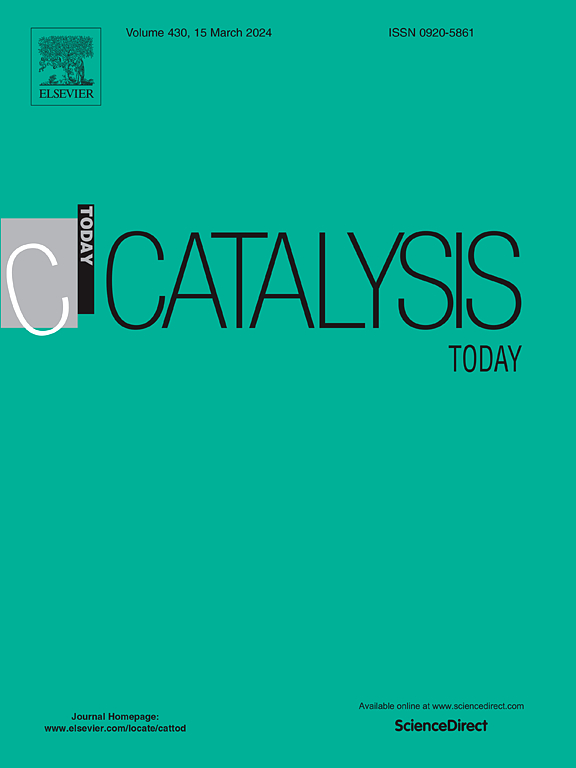Atomic layer deposited zinc promoted copper catalysts for carbon dioxide hydrogenation to methanol: Influence of support
IF 5.2
2区 化学
Q1 CHEMISTRY, APPLIED
引用次数: 0
Abstract
Copper promoted with zinc is an active catalyst for carbon dioxide hydrogenation to methanol, a reaction relevant to carbon capture and utilization technologies. Previous work showed that inverse zinc-on-copper catalysts on zirconia supports, where zinc(II) is added via atomic layer deposition (ALD), are more active and selective in this reaction than copper-on-zinc catalysts on zirconia. This work continues exploring the inverse zinc-on-copper catalysts by varying the support, comparing zirconia support with alumina, titania and niobia, and with various combinations of the ceria-zirconia-lanthana mixed oxide family. Catalyst characterization was made with elemental analysis, temperature-programmed reduction, temperature-programmed desorption of carbon dioxide, nitrous oxide pulse titration, and transmission electron microscopy. Activity was measured in a fixed-bed flow reactor at 450–550 K. ALD of Zn(II) acetylacetonate gave a similar areal number density of ca. two zinc per square nanometer on all tested supports. Zinc promotion systematically increased the methanol production rate. Among the tested catalysts, the zinc-on-copper on zirconia support remained the most active, with other catalysts from the ceria-zirconia-lanthana mixed oxide family giving almost as good results.
原子层沉积锌促进铜催化剂对二氧化碳加氢制甲醇的影响
锌对铜的促进作用是二氧化碳加氢制甲醇的活性催化剂,这是一个与碳捕获和利用技术相关的反应。先前的研究表明,在氧化锆载体上通过原子层沉积(ALD)添加锌(II)的逆锌-铜催化剂在该反应中比氧化锆载体上的铜-锌催化剂更具活性和选择性。本研究通过改变载体,比较氧化锆载体与氧化铝、二氧化钛和铌,以及不同组合的铈-氧化锆-镧混合氧化物家族,继续探索逆锌-铜催化剂。通过元素分析、程序升温还原、程序升温解吸二氧化碳、氧化亚氮脉冲滴定和透射电镜对催化剂进行了表征。活性在固定床流动反应器中测定,温度为450-550 K。乙酰丙酮锌(II)的ALD在所有测试支架上的面数密度相似,为每平方纳米约2个锌。锌的促进系统地提高了甲醇的产量。在所测试的催化剂中,氧化锆载体上的锌-铜催化剂仍然是最活跃的,其他来自铈-氧化锆-镧混合氧化物家族的催化剂也几乎具有同样好的效果。
本文章由计算机程序翻译,如有差异,请以英文原文为准。
求助全文
约1分钟内获得全文
求助全文
来源期刊

Catalysis Today
化学-工程:化工
CiteScore
11.50
自引率
3.80%
发文量
573
审稿时长
2.9 months
期刊介绍:
Catalysis Today focuses on the rapid publication of original invited papers devoted to currently important topics in catalysis and related subjects. The journal only publishes special issues (Proposing a Catalysis Today Special Issue), each of which is supervised by Guest Editors who recruit individual papers and oversee the peer review process. Catalysis Today offers researchers in the field of catalysis in-depth overviews of topical issues.
Both fundamental and applied aspects of catalysis are covered. Subjects such as catalysis of immobilized organometallic and biocatalytic systems are welcome. Subjects related to catalysis such as experimental techniques, adsorption, process technology, synthesis, in situ characterization, computational, theoretical modeling, imaging and others are included if there is a clear relationship to catalysis.
 求助内容:
求助内容: 应助结果提醒方式:
应助结果提醒方式:


